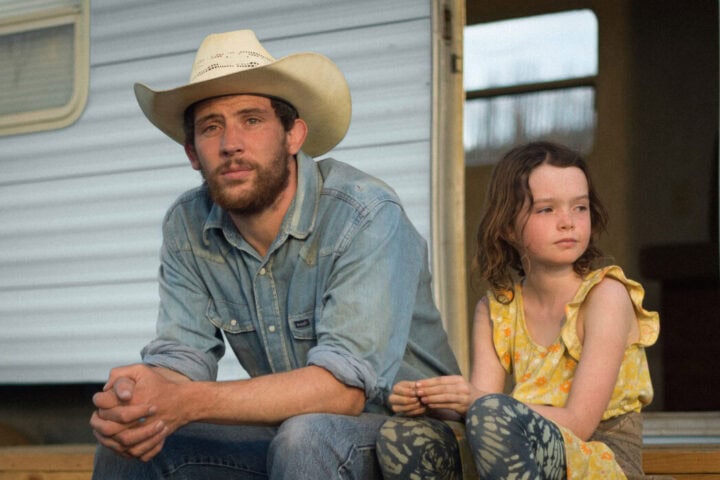A scene late in Albert Birney’s OBEX cuts tenderly to the heart of our growing nostalgia for analog forms of technology. Conor (Birney), an awkward man in his 30s, is having a fireside chat with Victor (Frank Moseley), who’s quite literally a bulky 1980s-era television set with a human body. Victor says that Conor looks familiar, and then the context hits him: He was the family TV in Conor’s childhood home, purchased by Conor’s father. While the family watched Victor, he also watched over them. Conor, who lost his father as a child, is reassured by Victor, who says that the dead man loved his son very much.
This moment is staged by Birney in the same tone as many of OBEX’s most moving scenes: with a wry absurdity that at once parodies and honors Conor’s tunnel vision. Victor is an artifact of Conor’s past, a link to an identity from which he feels estranged, and as such this character is Conor’s very own kind of earnest Tin Man. Many of us of a certain age may fetishize VHS tapes and cabinet-sized TVs and old Nintendo games and other period bric-a-brac for similar reasons. These are relics from a time that we associate with safety, with connections to figures of the past.
OBEX has the same personal, fly-by-night visionary quality as Birney and Kentucker Audley’s Strawberry Mansion. It’s a reminder that true midnight movies are more than genre films that happen to be balling on a budget: They are experiences, in which their creators invite you onto their outsider wavelengths. No one remembers David Lynch’s Eraserhead, which is a profound influence on OBEX, for its plot. Lynch’s film is a singular invitation to trance out, an otherworldly tuner fork that picks up on vibes thrumming just under the popular consciousness. OBEX isn’t as full-blooded a vision as Eraserhead, but Birney achieves a similar feat.
From its opening scenes, OBEX evinces an intensely tangible understanding of the draw of analog culture. Conor is an agoraphobic misfit who lives in a fairly large country house with a variety of VHS tapes and a tower of TVs, three in all, which are stacked on top of each other in the living room. For money, he fashions illustrations from photos that people send him of their loved ones, typing code in a rapid, chopsticks-like fashion on a keyboard to a computer that is, of course, old and bulky by our modern standards. The images that spring from the printer are unexpectedly lovely, the cold symbols of the coding cohering into poetry. An early intertitle is hilariously redundant, telling us that it’s 1987. Not a surprise, as this place is ’80s in all caps.
OBEX’s grainy black-and-white images yoke it to the past, with Josh Dibb’s beautiful electronic score deepening the period illusion. Eighties-era cosplay isn’t rare these days, but Birney’s command of atmosphere is unusually persuasive. For one, the filmmaker understands that period details need to be treated as if they’re just there. Contemporary period films tend to suggest wax museums, with fetishized props and wardrobes filmed in gauzy and inexpressive colors. When Conor watches Wes Craven’s A Nightmare on Elm Street on his three TVs, you feel as if you’re watching someone from the ’80s watching the movie, and for a few minutes you get to enjoy the movie yourself in a form of time travel. The images of the Craven film—in black-and-white triplicate—are rendered even less canny than they already were.
The first half of OBEX is a leisurely hang with Conor, his gadgets, and his dog, Sandy, who steals every scene that she’s in. Birney films this little dog with profound affection, capturing the bond of misfit people with their animals, who look upon their eccentric owners with an affirming matter-of-factness that often isn’t available to people from other humans. Sandy, played by a dog named Dorothy, gives Birney’s far-out concepts a grounding dimension.
That said, Birney doesn’t mount a heavy, self-pitying character study. It’s clear through various dreams and fantasies that Conor is wrestling with the loss of his family, but his solitary life with his hobbies and his dog is often shown to be pleasurable. This is a man who knows who he is, but, yes, he needs to rejoin the world. Our toys and even our dogs can only take us so far.
Conor’s cocoon is disrupted when he orders OBEX, a computer game that’s designed specifically for each of its patrons, so that they may appear as the protagonist in the sword-and-sorcery quest that drives the action. This notion is one of Birney’s many clever links between analog objects and the techno immersion of the modern world, in which the ability to blur your own self in with the endless sensations of social media is taken for granted (and from which analog culture implicitly offers a reprieve). At first, the game appears, hilariously, to be a primitive con, until Sandy is kidnapped by a demonic entity and Conor must essentially navigate the Land of Oz that now exists in his backyard. For an agoraphobic, a backyard might as well be Oz.
From there, Birney springs a fount of inventive wonders that shame blockbuster adventures given their intimacy and awesomeness, as the film’s special effects abound in the very tactility that inspires reverence for analog objects to begin with. When skeletons attack Conor in a dark field, they’re the sort of models that one used to encounter in high school science class, yet their fakery is odd and dreamlike; they’re creepier and, in their connection to the past, more resonant than a CGI ghoul on loan from some run-of-the-mill, bound-to-be-forgotten horror movie.
Though he’s an inventive and original stylist, Birney’s supreme gift as a filmmaker so far is his sense of innocence. He really means this movie, and the poignant irony of OBEX rests on how gadgets go from enabling Conor’s self-isolation to leading him back to the place of humans, to a life less easily mediated. Birney knows that fantasy is a potent force, that it can lead you deep into the worst parts of yourself, or, with the right influences, lead you back to life.
Since 2001, we've brought you uncompromising, candid takes on the world of film, music, television, video games, theater, and more. Independently owned and operated publications like Slant have been hit hard in recent years, but we’re committed to keeping our content free and accessible—meaning no paywalls or fees.
If you like what we do, please consider subscribing to our Patreon or making a donation.




